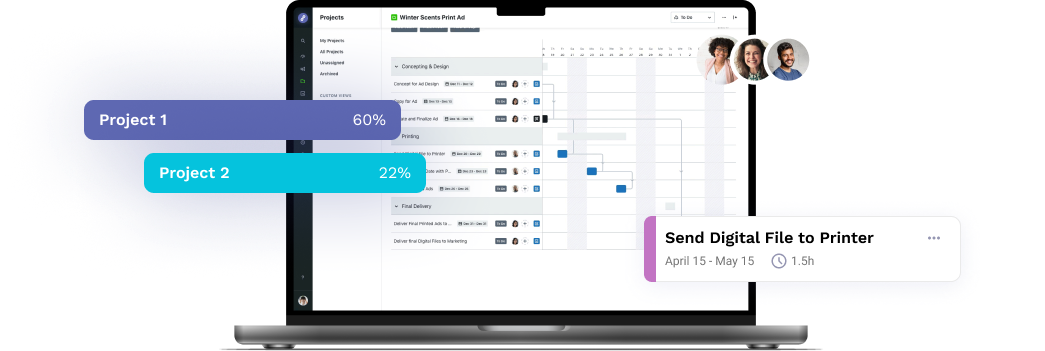
A successful long-term branding strategy is essential for every company, and the key component to great branding is consistency. Your company needs to deliver a seamless experience to build trust and loyalty. Given the countless points of contact between your brand and consumers, it’s essential that you have all brand collateral streamlined. Hiring someone may not be the best choice once a company enters a phase of hyper-growth. Thankfully, brand management tools and software have your back.
What Are Brand Management Tools?
The term ‘brand management tools‘ is self-explanatory. However, ‘brand management‘ is poorly understood and is not the same as building your brand.
When you search for brand management, you will likely find articles on positioning, mission and vision statements, and brand identity. These topics are well-known and generally tackled at the preliminary stages of a company. This is what we refer to as ‘brand building’. It’s an important set of actions and decisions that will set you off to a good start.
Building a Brand Checklist:
– Name and logo – Brand style (colors, fonts, tone of voice, visuals) – Brand positioning
– Mission and vision for your brand
After building a brand you have to learn how to manage it. You can do so by ensuring communication consistency among stakeholders, employees, customers, and shareholders. Make sure your message echoes loud and clear and branded content follows your guidelines. No stretched logos or inappropriate imagery should tie back to your brand.
Managing Your Brand Checklist:
Here’s a quick and easy checklist you can use to manage your brand well:
Brand consistency, strategy, awareness, alignment, recognition, and communication. Building trust with your audience.
Who Are Brand Management Tools For?
There are many internal and external stakeholders who benefit from using brand management tools. These tools better define your brand, make it more recognizable, and help with issues linked to brand management. Issues of collaboration, communication, coordination, and efficiency become a thing of the past.
Brand Managers
Your brand team is heavily involved in selecting the tools that can make or break your brand. Brand managers own the thankless task of being the guardians of the brand. They need brand management tools to create alignment within the entire company. Brand management tools help streamline brand operations, automate administrative tasks, and bring everyone on the same page.
Marketing Team
Marketing teams are the champions of attracting leads, generating demand, managing the content lifecycle, and keeping target audiences engaged. They are also struggling to stay consistent through all channels and messages. That’s on top of having to constantly increase content output and continually needing to perfect processes. Brand management tools make sharing, creating, controlling and publishing all your brand’s stories quick and easy.
Sales
Sales teams need ways to quickly get content that will impress leads, build relationships, encourage thought leadership and, most importantly, close more deals. Salespeople don’t have time to study brand guidelines in depth or track down rights for customer quotes and case studies. They are looking to bring new business to the company and would rather automate the time-consuming brand management stuff.
Partners Like Agencies and Resellers or Franchisers
Are you working with distributors, agencies, resellers and other external partners to sell or market your products or services? Then, you know they are not necessarily masters of designing promotional content. We often see stretched, substandard quality, and inconsistent ads and banners. Your partners don’t have the time or skills to create brand collateral, so they rely on you to support them. Brand management tools provide the support external partners need to create the promotional materials they need – without breaking brand consistency.
The Essential Brand Management Toolset
There’s a ton of brand management software solutions to streamline your work. Their purpose? To help you confidently present your brand to the world without being an all-things-branding mastermind. Here are some of our favorite tools for enforcing brand excellence:
Digital Asset Management System
Would you like to find a photo of a product taken at a specific side angle? Or would you like to use an old campaign picture and want to be sure you’re allowed to use it? Are you looking for an image that has the exact same shade of red as your company logo? Or would you like to use a picture with the brand logo on it, which is still up to date?
Digital Asset Management Software (DAM) is a robust platform that lets you store, organize, manage and distribute all of your digital content, from images to videos and beyond. It surpasses file-sharing platforms like Google Drive and Dropbox by eliminating the need to search through folders and email colleagues to find the right asset. It improves your brand consistency by offering the user content that is never outdated.
Style Guide Creation Tools
Brand guidelines are not just documents that collect information about your brand. They are key to brand alignment. Storing brand guidelines on a PDF document and sharing updated versions repeatedly will inevitably lead to misalignment. It’s a hassle for your colleagues to try and guess which file is the correct one and whose hard drive it’s on.
If all your stakeholders know and follow your brand guidelines, you have achieved brand alignment. This is essential in attracting new customers, satisfying, and keeping them.
Locked Content Templates
One of the biggest marketing and branding trends in recent years is content scalability. There are two key reasons for this:
- People need more content to be convinced
- They want personalized messages that speak to them directly
Companies are looking for cost-effective ways to be visible, relevant, and interesting to their target audience. On-brand content templates allow you and your colleagues to create and publish branded content directly from your asset storage solution without any design skills. Say goodbye to uploading and downloading different versions to edit or create material!
Make sure that you opt for a solution that allows you to work with professional design software. Working with the locked templates needs to be easy for the end-user but the quality should still be at a professional level. Lytho, for example, partners with Adobe through advanced integrations so that all materials created are top quality.
Lytho’s Brand Management Solution
There is no sense in buying several different solutions to maximize your brand’s consistency and connect all stakeholders to it. Especially since all these tools need to work closely together to reach your branding goals. Implementing several different pieces of software risks inconsistencies, and it can be a complex structure to manage. Users hate logging in and working from a bunch of different systems to get their work done. That’s why we developed Lytho, the central location and most user-friendly solution for all your brand management activities.
We can help you scale content and make your brand guidelines reach out to and resonate with all your employees and partners so you can focus on building a great brand. With Lytho, you can securely store, share, and create all your digital assets in a central location – no more duplicates or missing files.
– Manage interactive brand guidelines so that content is always consistent.
– Save time from coordination and build your brand awareness by creating new content.
– Enable your external stakeholders to stay brand consistent with locked content templates.
– Break through the designer bottleneck and enable everyone to create their own on-brand materials with software that is so easy to use it requires no training.
– Reduce agency costs.
– Integrate with all your favorite software, including Adobe InDesign.
How to Choose the Right System
Which solution is the best for managing your brand? Our recommendation is to focus on user experience, next to the functionalities your team needs. Otherwise, your tool will not be adopted by your teams and files will continue to live in unauthorized locations. When Lytho’s Brand Management Solution was designed and built, we prioritized intuitiveness and efficiency without sacrificing advanced technical features. These are some of the aspects you should consider when trying to score your DAM partner for user experience:
Taxonomy
It’s the way your tool organizes your data (digital assets). Most digital asset management systems use the old-fashioned folder structure which is not the most efficient, or intuitive way of storing your content. Think about it, when you go to Google or Pinterest you don’t open a folder and start eyeing different categories hoping to find the content you are looking for. That’s why you should opt for a more modern taxonomy.
Interface
Many brand management tools were built over a decade ago, which is why they have an early 2000s retro look about them. While it can be endearing to hop on down the memory lane to reminisce what using the World Wide Web was like back in the day, you really need a system that has a UI to match the modern workforce.
Translations & Language Support
If you are a globally operating company, have several official languages or market and sell your product or service in more than one country, you need a solution that supports translations and multiple languages.
AI Assistance
AI helps automate and predict tasks that are often mundane and take a lot of time day-by-day. Make sure that your preferred partner has skills in building AI-driven functionalities so your users can get off easier. Lytho, for example, has many AI functionalities. One of them is auto tagging, which ensures that when new assets are uploaded, they are correctly tagged and can be found easily. One thing less for your users to worry about.
Advanced Search
How do your users find your brand’s content? If you’re at a phase where you’re getting demos from different solutions, pay extra attention to the search capabilities of systems. With Lytho, you can look up images or videos by name or size, of course, but also by the exact shade of a certain color, ratio, file format, campaign, and so on.
Open API
An advanced brand management solution is not just a tool on its own, it should also integrate with your way of working and mold into your larger strategy. That’s why you need a tool that works together with other software that is important to you. Lytho’s generic API gives developers the opportunity to create integrations with other applications.
Lytho helps you streamline your entire workflow and harmonize all brand collateral under a single, uniform platform. Feel free to reach out to us by scheduling a demo and learning how our creative solutions can boost the effectiveness of your creative projects. We look forward to speaking with you!
Do you want to give yourself and your creative team more room for creative stimulation by automating the boring stuff? Lytho helps you streamline your entire workflow and harmonize all brand collateral under a single, uniform platform. Feel free to reach out to us by scheduling a demo and learning how our creative solutions can boost the effectiveness of your creative projects. We look forward to speaking with you!

Ready to simplify your creative operations and start having a little fun at work again? Schedule time to talk with us.
Let us show you how Lytho’s Creative Operations Platform helps in-house creative and marketing teams do better work, ease the stakeholder experience, and stay on brand.
Schedule a Demo